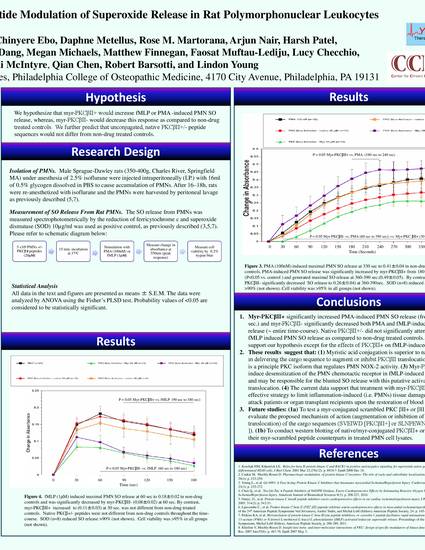
Phorbol 12-myristate 13-acetate (PMA; a diacylglycerol mimetic) is known to augment polymorphonuclear leukocyte (PMN) superoxide (SO) release via protein kinase C (PKC) activation. However, the role of PKC beta II (βII) mediating this response is not known. It’s known that myristic acid (myr-) conjugation facilitates intracellular delivery of the cargo sequence, and that putative PKCβII activator and inhibitor peptides work by augmenting or attenuating PKCβII translocation to cell membrane substrates (e.g. NOX-2). Therefore, we hypothesize that myr- conjugated PKCβII peptide-activator (N-myr-SVEIWD; myr-PKCβ+) would increase PMA-induced rat PMN SO release, whereas, myr-PKCβII peptide-inhibitor (N-myr-SLNPEWNET; myr-PKCβ-) would attenuate this response compared to non-drug treated controls. Rat PMNs (5x106) were incubated for 15min at 370C in the presence/absence of myr-PKCβ+/- (20 μM) or SO dismutase (SOD;10μg/mL; n=8) as positive control. PMA (100nM) induced PMN SO release was measured spectrophotometrically at 550nm via reduction of ferricytochrome c for 390 sec. PMN SO release increased absorbance to 0.39±0.04 in non-drug treated controls (n=28), and 0.49±0.05 in myr-PKCβ+(n=16). This response was significantly increased from 180 seconds to 240 seconds (p<0.05). By contrast, myr-PKCβ- (0.26±0.03; n=14) significantly attenuated PMA-induced SO release compared to non-drug controls and myr-PKCβ+ (p<0.05). SOD-treated samples showed >90% reduction of PMA-induced SO release and was significantly different from all groups (p<0.01). Cell viability ranged between 94± to 98±2% in all groups as determined by 0.2% trypan blue exclusion. Preliminary results suggest that myr-PKCβ- significantly attenuates PMA-induced SO release, whereas myr-PKCβ+ significantly augments PMA-induced SO release, albeit transiently. Additional dose response and western blot experiments are planned with myr-PKCβ+/- in PMA-induced PMN SO release assays.
This research was supported by the Department of Bio-Medical Sciences and the Division of Research at PCOM and by Young Therapeutics, LLC.
Available at: http://works.bepress.com/lindon_young/82/
